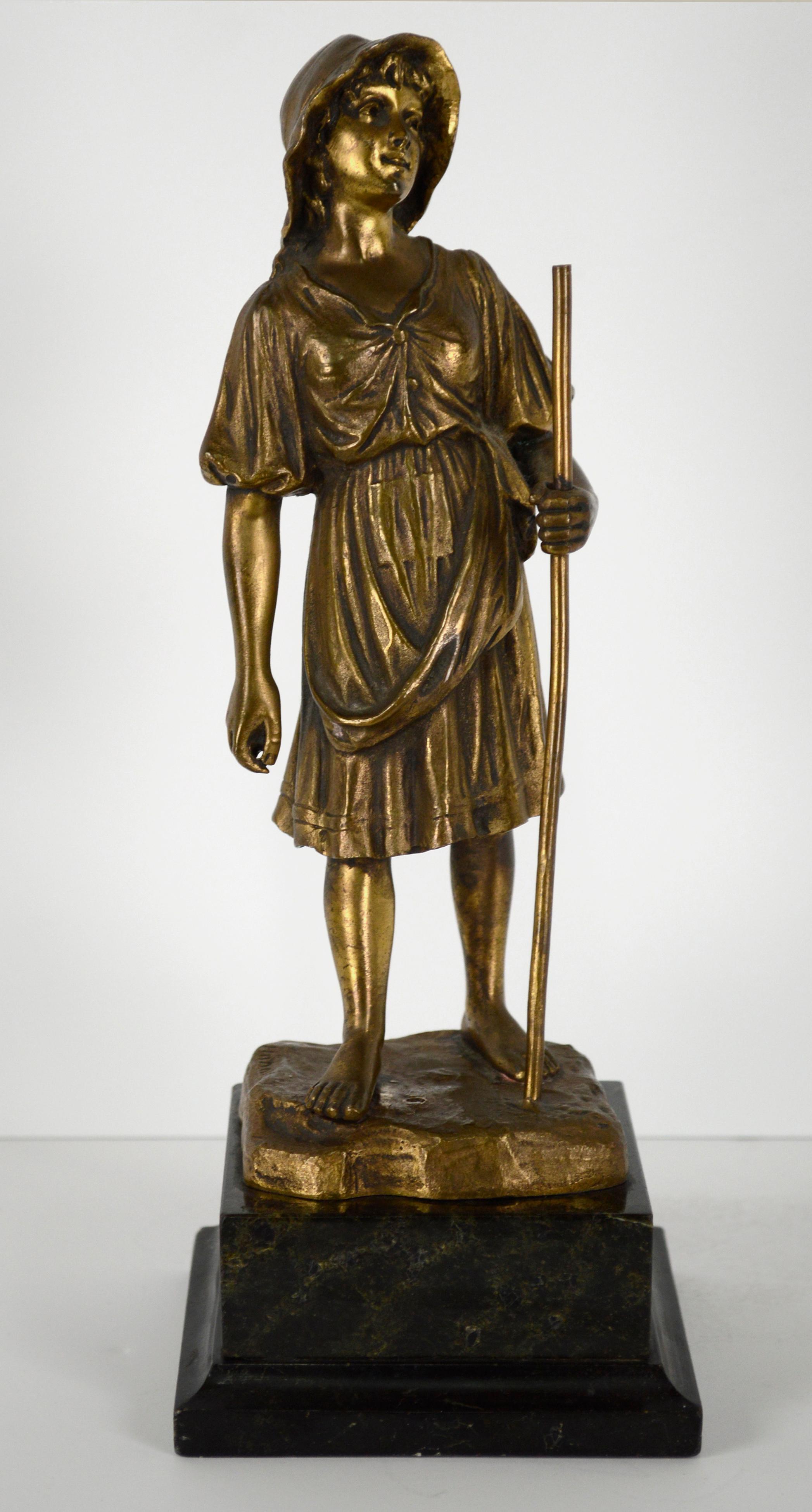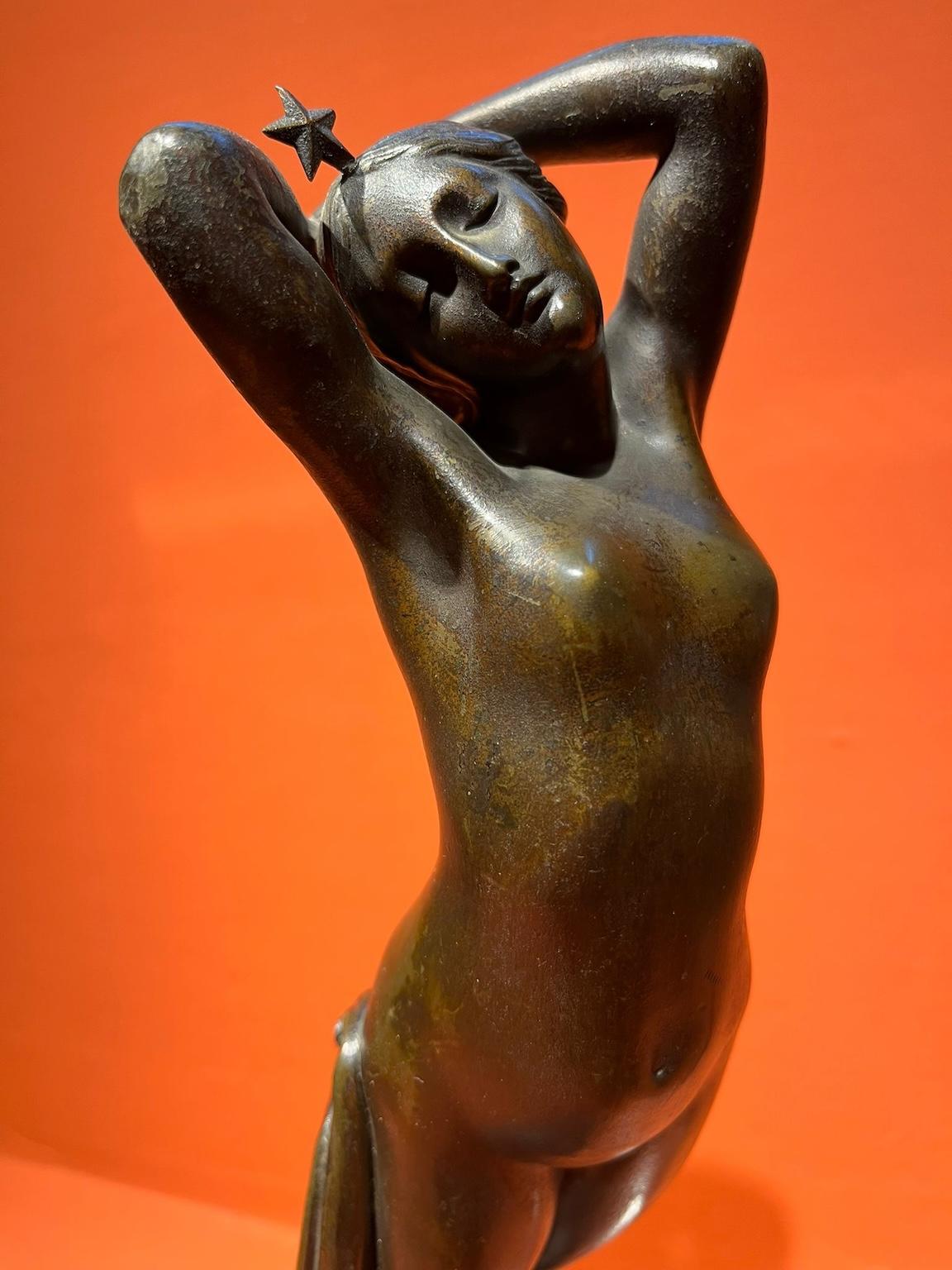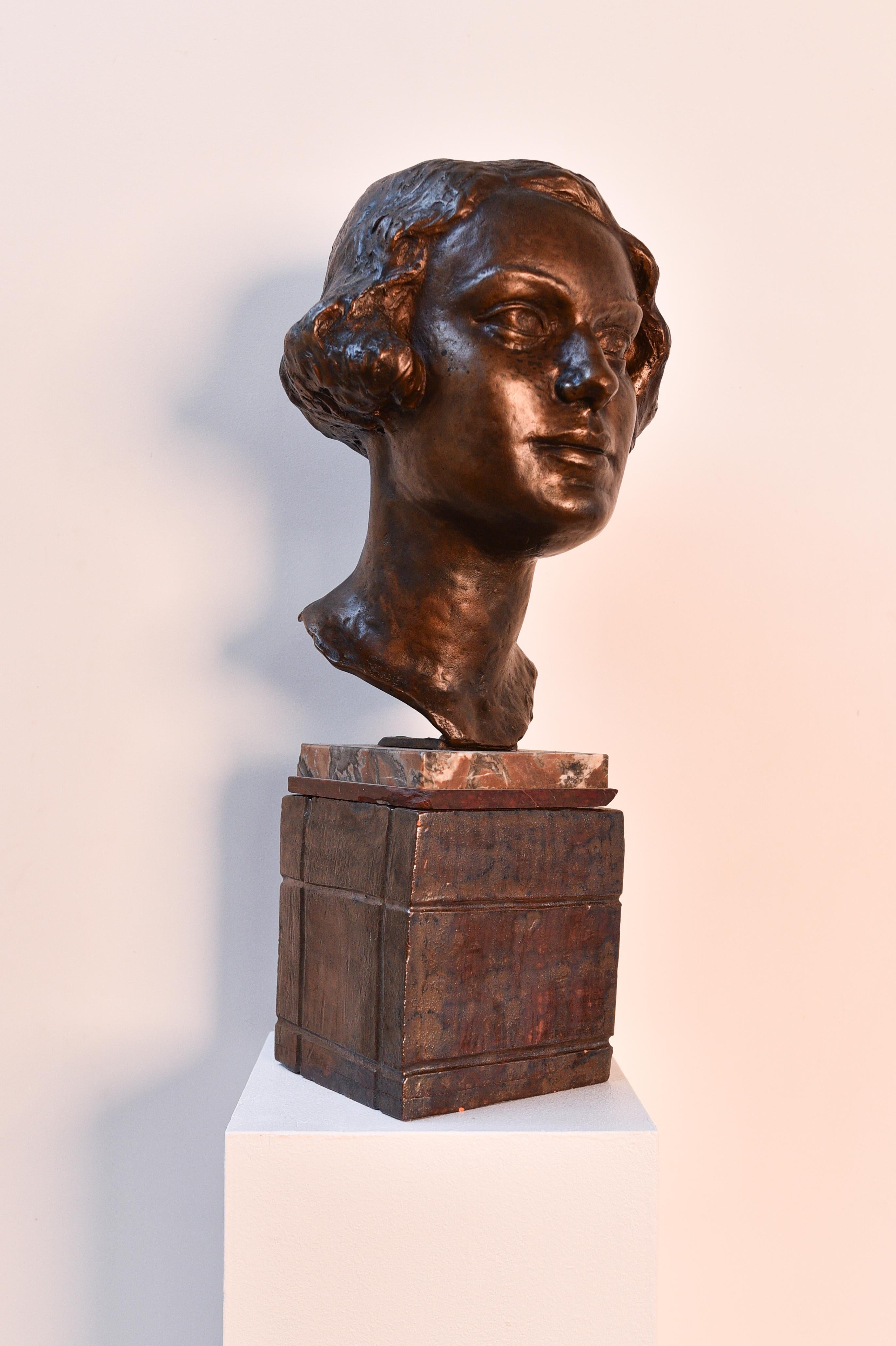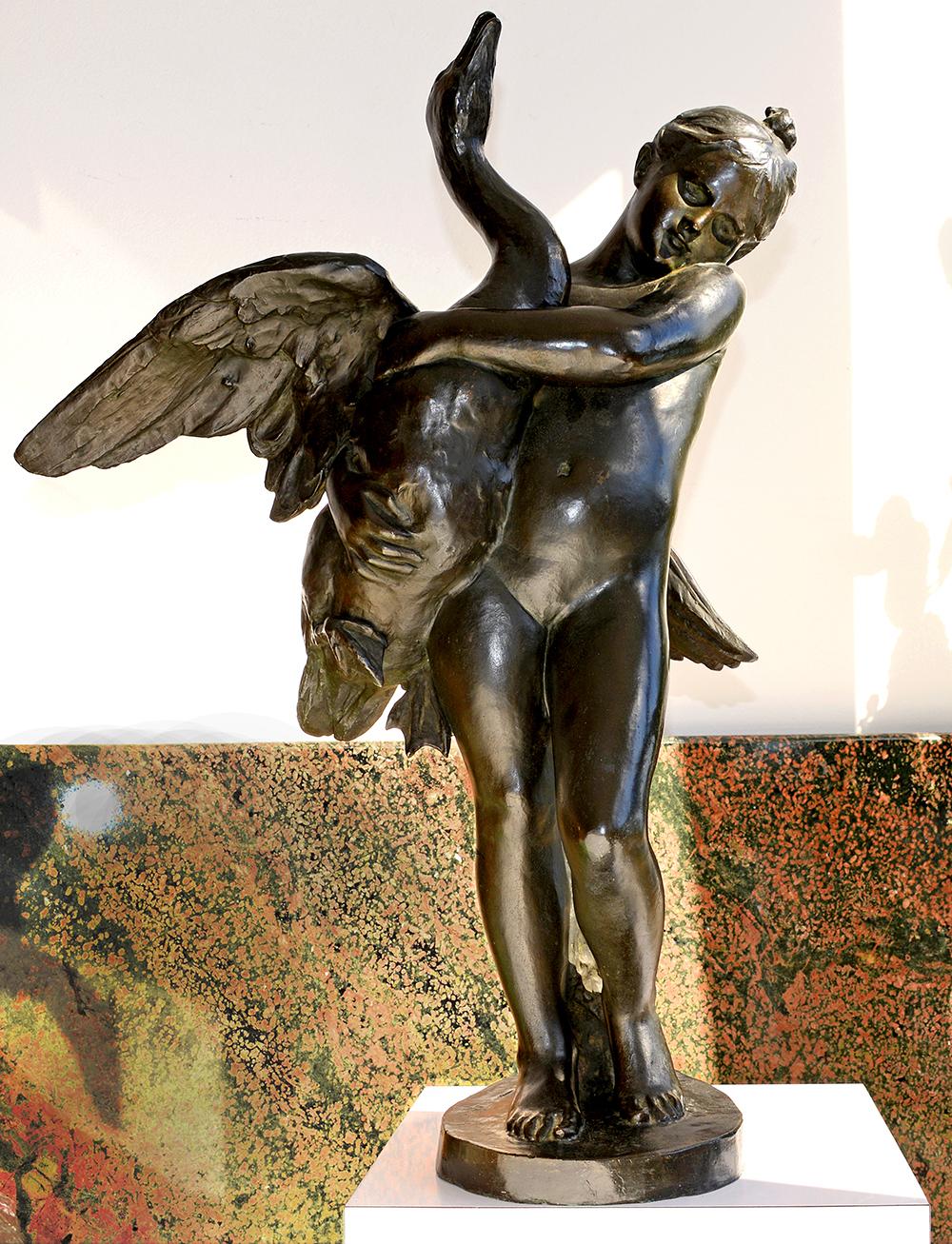Items Similar to La Cothurne
Want more images or videos?
Request additional images or videos from the seller
1 of 9
Agathon LéonardLa Cothurne1901
1901
About the Item
"La Cothurne" 1901
Gilt Bronze
Approx 21.5" High (to raised hand)
Signed and Dated
Foundry Mark "Susse Freres"
Originally modeled in white biscuit porcelain this Greek dancer is a from a set of eight created for a dining table. They were immediately successful when they were exhibited in the Sevres pavilion at the 1900 Exhibition. Individual figures could be ordered and "La Cothurne" proved the most popular. Their success led to the firm of Susse buying the right to cast versions in metal.
Agathon Leonard (1841-1923) is one of the well-known French Art Nouveau sculptors. Born in Lille in 1841, he first studied there before moving to Paris where he studied at the Ecole des Beaux Arts under Eugene Delaplanche.
He gained recognition at the annual Expositiones Universelles, winning a Silver Medal there in 1889 and gold in 1900. His most important piece, Jeu L'echarpe, was the best known series of Sevres production at the turn of the century and sold out at the 1900 Expo in Paris and later was given as a gift by the French Gov't to Nicholas II at the Hermitage.
His bronzes were cast at the Susse Freres Editeurs Foundry. He worked also in marble, quartz and ivory. He also produced Art Nouveau medallions, statuettes and pottery.
His work is held at the Victoria & Albert Museum, the Art Institute of Chicago, and Abbeville and Nantes Museums.
He became a member of the Societe des Artistes Francois in 1887 and the Society Nationale des Beaux-Arts in 1897. He was made a chevalier of the Legion d'Honneur in 1900.
- Creator:Agathon Léonard (1841 - 1923, French)
- Creation Year:1901
- Dimensions:Height: 21.5 in (54.61 cm)Width: 6 in (15.24 cm)
- Medium:
- Movement & Style:
- Period:
- Condition:
- Gallery Location:Missouri, MO
- Reference Number:1stDibs: LU74732666973
About the Seller
5.0
Vetted Seller
These experienced sellers undergo a comprehensive evaluation by our team of in-house experts.
Established in 1970
1stDibs seller since 2017
142 sales on 1stDibs
Typical response time: 21 hours
- ShippingRetrieving quote...Ships From: Missouri, MO
- Return PolicyA return for this item may be initiated within 2 days of delivery.
More From This SellerView All
- Study AimBy Carl KaubaLocated in Missouri, MOCarl Kauba "Study Aim" c. 1920 Bronze with Brown Patina Signed approx. 9.5 x 10 x 4 This Austrian sculptor was born in Vienna in 1865. His teachers were Karl Waschmann (1848-1905), known for his ivory sculptures and portrait plaquettes of contemporary celebrities, and Stefan Schwartz (1851-1924), who exhibited in Paris, including the Exposition Universelle of 1900 where he won a gold medal. Kauba's intricate bronzes, imported to the United States between 1895 and 1912, were cast at the Roman Bronze Works. Kauba was part of the nineteenth-century tradition of polychrome bronze sculpture. There were several types of patinas on a single statue: he could render the color of buckskin, variously tinted shirts, blankets, feathers, as well as beaded moccasins. Reportedly, Kauba came to America around 1886. Inspired by the Western tales of German author Karl May, he traveled to the West and made sketches and models. Critics, however, pointed out inaccuracies of costume and other details. For instance, the guns that his "mid-nineteenth-century" figures use are models produced after 1898. Apparently he did all of his works back in Vienna. Besides the variety of color, Kauba's bronzes show a great range of textures and his style is highly naturalistic. The sculptor loved ornament, some of which he rendered with coiled wire for reins, rope and feathers in headdresses. He successfully rendered figures in motion and often executed compositions with more than one figure. Berman (1974) illustrates non-Western subjects by Kaula, such as the pendants Where? and There (ca. 1910), a seated Scottish couple, impressive in the expressions and the details on patterned fabrics of both sitters. Another genre piece is Buster Brown...Category
Early 20th Century Realist Figurative Sculptures
MaterialsBronze
- Going into BattleBy Carl KaubaLocated in Missouri, MOCarl Kauba "Going into Battle" c. 1920s Bronze with Brown Patina Signed approx 10 x 10 x 4 (including wooden base) This Austrian sculptor was born in Vienna in 1865. His teachers were Karl Waschmann (1848-1905), known for his ivory sculptures and portrait plaquettes of contemporary celebrities, and Stefan Schwartz (1851-1924), who exhibited in Paris, including the Exposition Universelle of 1900 where he won a gold medal. Kauba's intricate bronzes, imported to the United States between 1895 and 1912, were cast at the Roman Bronze Works. Kauba was part of the nineteenth-century tradition of polychrome bronze sculpture. There were several types of patinas on a single statue: he could render the color of buckskin, variously tinted shirts, blankets, feathers, as well as beaded moccasins. Reportedly, Kauba came to America around 1886. Inspired by the Western tales of German author Karl May, he traveled to the West and made sketches and models. Critics, however, pointed out inaccuracies of costume and other details. For instance, the guns that his "mid-nineteenth-century" figures use are models produced after 1898. Apparently he did all of his works back in Vienna. Besides the variety of color, Kauba's bronzes show a great range of textures and his style is highly naturalistic. The sculptor loved ornament, some of which he rendered with coiled wire for reins, rope and feathers in headdresses. He successfully rendered figures in motion and often executed compositions with more than one figure. Berman (1974) illustrates non-Western subjects by Kaula, such as the pendants Where? and There (ca. 1910), a seated Scottish couple, impressive in the expressions and the details on patterned fabrics of both sitters. Another genre piece is Buster Brown...Category
Early 20th Century Realist Figurative Sculptures
MaterialsBronze
- The Hunter and HoundBy Pierre Jules MêneLocated in Missouri, MOPierre-Jules Mene "The Hunter and Hound" (Le Valet de Limier) 1879 Bronze approx. 19 x 8 x 14 inches Signed PIERRE JULES MENE (1810-1879) Pierre...Category
1870s Realist Figurative Sculptures
MaterialsBronze
- Leda and the SwanBy Albert-Ernest Carrier-BelleuseLocated in Missouri, MOAlbert-Ernest Carrier-Belleuse (French, 1824-1887) "Leda and the Swan" c .1858 Bronze w/Gold Patina 18 x 24 x 14 Signed "A. Carrier" Based upon a c...Category
Late 19th Century Victorian Figurative Sculptures
MaterialsBronze
- Seagull LampLocated in Missouri, MOWilliam F. Boogar, Jr. Seagull Lamp 1946 Bronze approx. 15 1/4" High x 6 1/2" Wide Signed and Dated Bottom WILLIAM F. BOOGAR, Jr., the Provincetown sculp...Category
1940s Modern Figurative Sculptures
MaterialsBronze
- Regina EnthronedBy Lazzaro DonatiLocated in Missouri, MOLazzaro Donati (Italian 1926-1977) "La Regina" Bronze Signed on Base Size: approx 19 x 9 x 9 inches Lazzaro Donati (1926-1977) was born in Florence in 1926 and attended the Academy of Fine Arts. He began to paint in 1953, and in 1955 held his first exhibition at the Indiano Gallery in Florence. Within three years eleven exhibitions followed in Italy, and as his reputation grew he was invited to give major exhibitions in London, Paris, New York, Chicago, Rio de Janeiro and Montevideo. He is considered one of the foremost contemporary Italian painters and his paintings hang in museums and private collections throughout the Americas, Europe and Asia. Mr. Donati lived and worked at 24 Piazza Donatello in Florence, the square where generations of artists have created works worthy of the great Florentine tradition. As you entered the narrow hallway to his studio, a gilded life-size Venetian angel beckoned you to his door. Once inside, the present faded away and you found yourself in an atelier where early masters might have worked during the Renaissance. Within, luxurious Persian rugs set off the innumerable objects d'art and antique furnishings. Light poured in through the sloping glass wall on the north side. A dramatic stairway led to an overhanging balcony which served as a private gallery where the artist hung some of his favorite early works. To the left of the entrance was a smaller studio where Donati sculpted, with a window overlooking the famous old English cemetery where tourists laid flowers on the grave of Elizabeth Barrett Browning. In the main studio itself, where Donati received his clients in an atmosphere as polished as an office of a top executive, one hardly realized that it was here that the artist actually painted. His easel was covered with Persian blue velvet, the painting on the easel was already framed, his chair was upholstered in red velvet and on his palette the colors were arranged with the precision of a Byzantine mosaic. In a corner stand were his latest works, framed and ready to be sent off to his next exhibition in Europe or America. Donati was a born host with a warm welcome, an elegant man who possessed enormous charm a good nature and a keen sense of humor. Apparently shy, he preferred to speak on subjects extraneous to his art, purposely distracting you from his paintings, then leading you back to them, tactfully and without pretension. He spoke fluent French and English as well as some Spanish and German. "After all", he said, "you've got to know how to sell a painting to everyone." He had no sympathy for the "drip and splash" studios of his contemporaries, preferring to keep his studio tidy and spotless. "Painting is a matter of precision", he said, "If a painter can't put his paint where he wants it to go, I don't see how he can call himself a painter. For me it is absolutely necessary to control the paint." When asked to reveal the technique he used to achieve the enamel-like finish typical of his paintings he answered, "That is a secret between me and my butler. Actually, most of my paintings are done by him!" But in fact behind the façade, Donati was a serious craftsman who devoted to his painting as a way of life and means of expression. From the beginning of his career, his paintings revealed a striving for perfection and continual research in problems of style and technique. His early works indicated a momentary interest in surrealism and abstract art; they were predominantly two dimensional, depending on line and strong color. But by 1958, with his painting The Lady with a Fan...Category
Late 20th Century Modern Figurative Sculptures
MaterialsBronze
You May Also Like
- Early 20th Century Bronze Figure Sculpture, Shepherd Girl with Staff StatueLocated in Soquel, CAWonderful miniature bronze cast figurative sculpture of a young barefoot shepherd girl holding a staff by R. Hobold (German, 19th c). The girl is dressed in a flowing peasant dress a...Category
Early 20th Century Jugendstil Figurative Sculptures
MaterialsMarble, Bronze
- 19th century French mythological figurative female bronze statuetteBy Joseph PolletLocated in Florence, ITLate 19th-century bronze figure derived from a work by Jean Michel-Angel Pollet-a Palermo artist of French parents who was a pupil of Bertel Thorvaldsen and Peter Tenerani - titled ...Category
Late 19th Century Art Nouveau Nude Sculptures
MaterialsBronze
- Antoine Bofill Art Nouveau Nude Bronze Sculpture, circa 1900By Antoine BofillLocated in Dallas, TXThis is one of Antoine Bofill's best models, being a signature Art Nouveau nature form with a beautiful nude nymph gazing upon a bumble bee insect. The patina on this statue figure i...Category
Early 1900s Art Nouveau Figurative Sculptures
MaterialsBronze
- Early 20th century art nouveau bronze buste of a woman on a ceramic socleLocated in Oostende, BEUnsigned bronze buste of a woman, with fine characteristics. The sculpture was mounted on a hand-made ceramic socle with a marble top. Very heavy, solid and qualitative piece.Category
Early 20th Century Art Nouveau Figurative Sculptures
MaterialsMarble, Bronze
- Nude Girl and Swan BronzeLocated in Miami, FLThis stylized figural study captures a young girl restraining a struggling swan trying to take flight purportedly by Marius Jean Antonin Mercié, bearing the incised signature “Mercié” on the base.. The work is quite heavy weighing in about 65 lbs and boasts an opulent dark patina. Unlike his signature work Gloria Victis, that has numerous versions, reproductions and casts, Girl and Swan may be of just a few casts or may be unique. With Barbedienne foundry mark on the tree stump behind the left foot. Mercie used Barbedienne for many of his works. Purchased from Toulouse Antiques...Category
1910s Art Nouveau Nude Sculptures
MaterialsBronze
- "Art Nouveau Bronze Sculptural of a Boy and Girl", 20th Century by Juan ClaráLocated in Madrid, ESJUAN CLARÁ AYATS Spanish, 1878 - 1958 ART NOUVEAU SCULPTURAL BRONZE OF A BOY AND GIRL signed "Juan Clara" (on the lower left ) sculptural bronze 4-3/8 x 4-3/8 x 3-1/2 inches (11 X 11 X 9 cm.) PROVENANCE Private Spanish Collector Art Nouveau Bronze sculpture representing a boy and a girl sitting on a stool in a funny and surprised attitude to something they are seeing. Sgned "Juan Clará" lower left with the foundry seal and marks on the right side of the bench Juan Clará Ayats. Olot (Gerona), 6.XII.1875 - Paris (France), II.1958. Sculptor Student of José Berga at the Olot School of Fine Arts, developed his training in France, first at the School of Fine Arts in Toulouse, in 1896, and from 1901 in Paris. At this stage he lived with his younger brother, José Clará...Category
1920s Art Nouveau Figurative Sculptures
MaterialsBronze
Recently Viewed
View AllMore Ways To Browse
1900 Exhibition
Ivory Art D
Medallion Sculpture
Art Nouveau Dancers
Art Nouveau Marble Sculptures
Art Nouveau Ivory
Antique Ivory Sculpture
Antique Ivory Sculptures
Statuettes Gold
Art Nouveau Medallions
Sculpture Biscuit
Bronze And Ivory Sculpture
Biscuit Porcelain Sculptures
Art Nouveau French Pottery
Marble Sevres
French Provence Pottery
Sculpture Porcelain Dancer
White And Gold Sevres Porcelain




